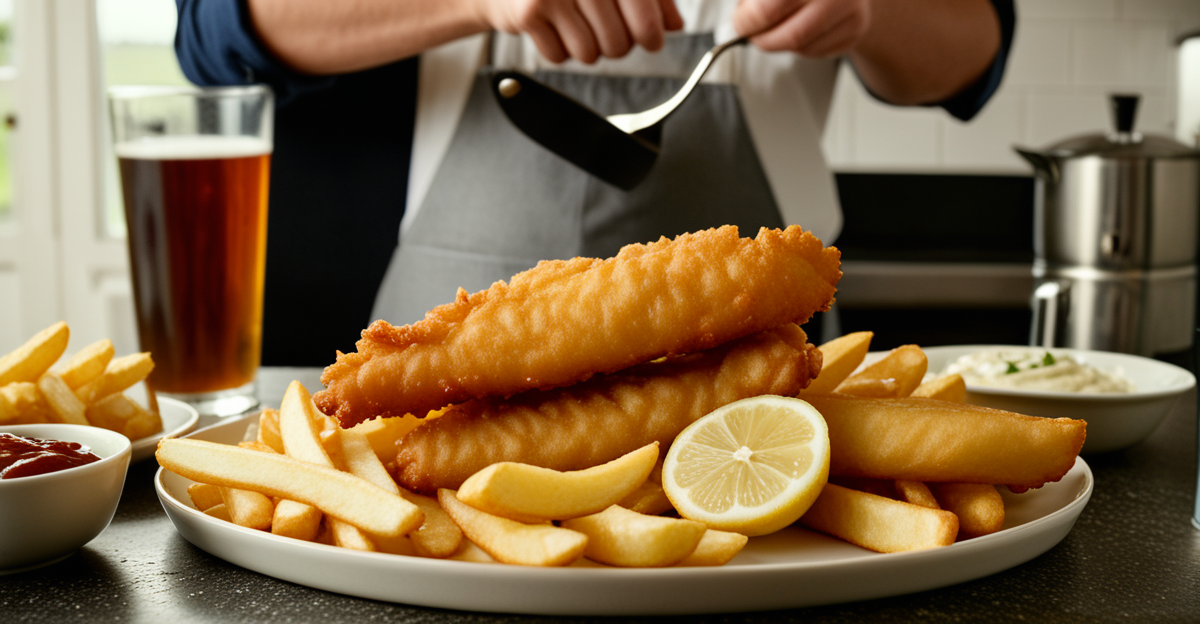Essential Ingredients and Equipment for Authentic British Fish and Chips
To achieve authentic British fish and chips, selecting the right ingredients is paramount. The fish should be firm white varieties such as cod or haddock, prized for their flaky texture and mild flavour. Potatoes must be starchy, like Maris Piper or King Edward, to produce chips that are fluffy inside yet crispy outside.
The traditional batter relies on simple, quality ingredients: plain flour, baking powder, cold sparkling water or beer, and a pinch of salt. This combination creates a light, crisp coating, essential for genuine British fish and chips. Experimenting with batter temperature—keeping it chilled—helps achieve the signature crunch.
Also read : How do you achieve the ideal texture in a bread and butter pudding?
Essential equipment includes a deep fryer or a heavy-bottomed pan to maintain stable frying temperature, preferably around 180°C (350°F). A thermometer is crucial to monitor this precisely. A slotted spoon or spider skimmer facilitates safe removal of delicate fish and chips from hot oil without sogginess. Additionally, newspaper or greaseproof paper remains the traditional choice for serving, preserving the authentic experience.
Mastering these basics equips you to replicate the classic British dish with confidence, respecting both ingredients and traditional preparation methods.
Also read : Is Traditional British Cuisine Making a Comeback in Modern Kitchens?
Step-by-Step Guide to Preparing Fish and Chips at Home
Mastering how to cook fish and chips at home hinges on precise preparation for both fish and chips. Begin by cutting starchy potatoes into even, thick strips to ensure they cook uniformly. Soaking them briefly in cold water removes excess starch, improving crispiness. Dry the chips thoroughly before frying to prevent oil splatter and soggy results.
When battering fish, use chilled batter made from plain flour, baking powder, and cold sparkling water or beer. The cold temperature is key: it creates a light, crunchy texture upon frying. Dip the fillets fully and allow excess batter to drip off for an even coating.
The British fish and chips method involves frying at a steady 180°C (350°F). Start by frying chips until pale golden, remove, and drain. Next, fry fish until the batter puffs and turns brilliantly crisp and golden. Finally, return chips to the oil for a second fry to achieve that fluffy yet crispy texture prized in an authentic British fish and chips recipe. This double-frying technique balances perfect moisture inside with a satisfying crunch outside—crucial for replicating restaurant-quality results at home.
Achieving the Perfect Crispy Finish
Achieving crispy fish and chips involves precise temperature control and technique. The best frying temperature is around 180°C (350°F). Maintaining this temperature avoids greasy, soggy results. The British fish and chips secrets are deeply rooted in the double-frying method: first, the chips are fried until pale gold, then rested; fish follows with a single fry until the batter crisps; finally, chips return for a second fry, yielding a fluffy interior with a crunchy exterior.
Proper draining and resting are essential. Once fried, fish and chips must be removed from oil and placed briefly on paper towels or a wire rack to drain excess oil. This step preserves maximum crunch and prevents moisture buildup, which can soften the batter and chips.
Common mistakes include overcrowding the fryer, which lowers oil temperature, resulting in greasy texture. Also, batter inconsistencies or using warm batter reduce crispness. To ensure the signature crispy fish and chips, always keep batter cold and oil temperature steady. This careful attention to technique and timing is key to replicating an authentic British fish and chips texture at home.
Serving Suggestions and Traditional Accompaniments
Serving authentic British fish and chips goes beyond the food itself. Classic fish and chips sides enhance the experience. Mushy peas are a traditional accompaniment—creamy, slightly sweet, and vibrant green, they balance the richness of fried fish and chips perfectly. A dollop of tartar sauce adds a tangy, creamy contrast that complements the crispy batter. Pickled onions or gherkins introduce a sharp, acidic bite, cutting through the fried texture.
Proper presentation remains key. Traditionally, fish and chips are served wrapped in newspaper or greaseproof paper, which retains warmth while allowing ventilation to keep the food crisp. Serving on simple plates with a sprinkle of salt and a dash of malt vinegar is customary. This vinegar’s sharp acidity enhances the flavour profile, making it a staple condiment.
Other classic British condiments include tomato ketchup and curry sauce, popular regional options that add variety. Understanding these serving practices and traditional accompaniments lets you recreate an authentic British fish and chips meal that respects culinary heritage and delights the palate with every bite.
Cultural Significance and History of British Fish and Chips
British fish and chips hold a unique place in British food culture, originating in the mid-19th century as a convenient, affordable meal for the working class. The dish combines influences from Jewish fried fish traditions and fried potato preparations popular across Europe. This culinary fusion made fish and chips widely accessible, fueling its rapid popularity across the UK.
The history of fish and chips reflects social change, especially during industrialisation, when quick, hearty meals were essential for labourers. Fish and chip shops, known as “chippies,” became community hubs, embedding the dish deeply in everyday British life. Its affordability and satisfying flavours cemented it as a staple, often described as the nation’s favourite takeaway.
Regional variations also contribute to its rich heritage. Differences in batter style, types of vinegar used, or chip thickness highlight the diversity within this classic dish. Many longstanding fish and chip shops maintain original recipes and methods, preserving tradition while continuing to serve new generations. This enduring appeal explains why authentic British fish and chips remain firmly rooted in the UK’s culinary identity.








